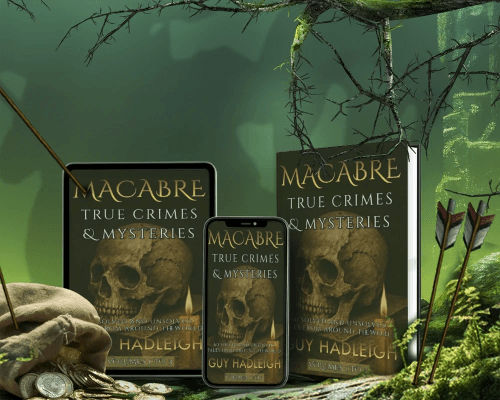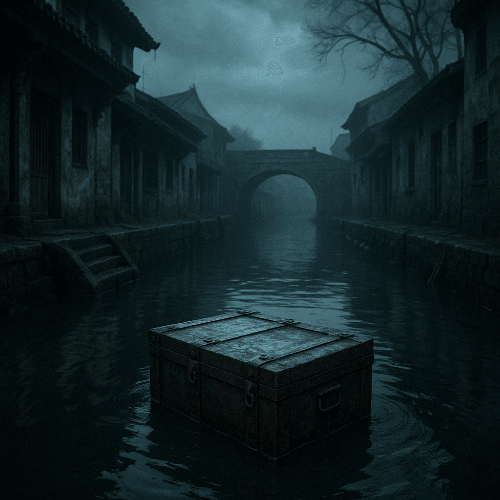
Macabre True Crimes & Mysteries: 60 Shocking Tales That Defy Belief
Enter the World of the Macabre
True crime has always fascinated people. From late-night ghost stories to forensic TV dramas, we’re drawn to mysteries that challenge our understanding of humanity. But some stories are far darker—and stranger—than anything fiction could invent.
That’s exactly what Guy Hadleigh’s 3-volume collection, Macabre: True Crimes & Mysteries delivers. With 60 real cases from around the world, the series dives deep into the chilling, bizarre, and often unsolved crimes that have left scars on history.
This post will take you inside the book, highlighting some of its most haunting stories—from Thailand’s first serial killer to Australia’s greatest colonial mystery—while exploring why we’re so captivated by tales of murder, betrayal, and the unknown.
The Iron Box Killer: Thailand’s First Serial Murderer

The killer? Boonpeng Buaklee, a self-styled holy man who posed as a monk. Instead of offering blessings, he lured wealthy women, drugged them, and strangled them before sealing their remains in iron boxes.
The case horrified a deeply religious society, forcing Thailand to reform how monks were ordained. Boonpeng was eventually executed by beheading—the last man in Thai history to face that method of death.
Even today, children in Bangkok whisper his name as a ghost story: Heep Lek—the man of the iron box.
The Gatton Murders: Australia’s Colonial Mystery
On Boxing Day, 1898, three siblings—Michael, Ellen, and Norah Murphy—were brutally murdered on their way home from a canceled dance in Gatton, Queensland. Their bodies were discovered arranged in a deliberate, almost ritualistic formation.
Despite the arrival of top detectives, 79 witnesses, and a massive public inquiry, no one was ever charged. Theories ranged from rejected suitors to itinerant criminals, but nothing was proven.
The Gatton Murders remain Australia’s most infamous unsolved colonial crime, haunting the Lockyer Valley for over a century.
The Aramoana Massacre: 22 Hours of Terror
Fast forward to 1990 New Zealand, a peaceful fishing town turned into a battlefield. A reclusive gun enthusiast, David Gray, snapped after a dispute with neighbors and went on a 22-hour shooting spree, killing 13 people, including children and a police officer.
The massacre shocked New Zealand, a nation with one of the lowest rates of gun violence in the world. It also led to the country’s first major gun reforms, restricting access to military-style weapons.
To this day, Aramoana stands as a grim reminder of how quickly isolation and untreated mental illness can erupt into mass tragedy.
The Heineken Kidnapping: When Crime Went Corporate
Not all of the book’s stories are about murder. Some are about money, power, and sheer audacity.
In 1983 Amsterdam, five small-time criminals pulled off the impossible: they kidnapped beer tycoon Freddy Heineken demanding the largest ransom in Dutch history—35 million guilders.
Held in soundproofed cells for three weeks, Heineken survived, but the case changed organized crime forever. Mastermind Willem Holleeder later became the Netherlands’ most feared crime boss, while Heineken’s story inspired books and films worldwide.
The Children of Thunder: A Cult’s Deadly Prophecy
In California, 2000, a fisherman found dismembered bodies stuffed into duffel bags. The killers? Not gangsters—but a suburban cult.
Led by former Mormon missionary Taylor Helzer, the “Children of Thunder” believed they were chosen to usher in the apocalypse. Their “Five Point Plan” included kidnapping, bank fraud, and ritual murders.
Within a week, five innocent people were dead—including an elderly couple, a young woman, and her mother. Helzer was sentenced to death, but California’s moratorium means he remains on death row to this day.
Just a brief overview of a book brimming with tales to shock and intrigue - get your copy now!
Why We’re Drawn to the Macabre
So why do stories like these captivate us?
1. They reveal human psychology – The Iron Box Killer wasn’t just a murderer; he exploited faith and trust.
2. They challenge societal safety nets – Gatton proved even small, tight-knit towns aren’t immune to horror.
3. They spark cultural change – Aramoana directly reshaped gun laws.
4. They linger unsolved – Some crimes, like Gatton, never find closure, leaving endless room for speculation.
FAQs About Macabre: True Crimes & Mysteries
Q1: Is the book based on real cases?
Yes. All 60 stories are based on documented events, though some names and details have been altered for privacy and flow.
Q2: Does it cover only serial killers?
No. The book spans a wide range of crimes—serial killings, kidnappings, massacres, cult murders, unsolved mysteries, and political assassinations.
Q3: Is it graphic or sensationalized?
The writing is vivid but respectful. The goal is historical and psychological insight, not glorification.
Q4: Who is the author?
Guy Hadleigh, a researcher and writer with a passion for crime history and global mysteries.
Q5: Is this book good for fans of unsolved mysteries?
Absolutely. From the Dyatlov Pass Incident to the Isdal Woman, the collection includes famous and lesser-known mysteries that remain unsolved.
Q6: Where can I get the book?

